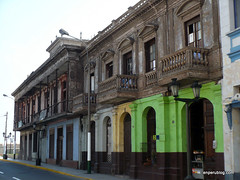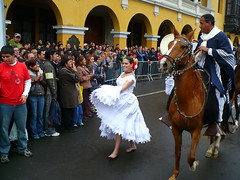The sights and sounds of bohemian Barranco in southern Lima are captured beautifully in this video below. Among the ageing colourful buildings, children play, street sellers sell, diners dine and people generally go about their business unaware that they are being observed from afar.
Category: "Travel and Places"
Huaca Huallamarca
In the heart of lush residential San Isidro, the Huaca Huallamarca is one of dozens of pre-Columbian sites found within the city of Lima – a densely populated area even then. Heavily restored and open to tourists, the pyramid sits surrounded by huge modern penthouses that are a stark and unusual contrast for such an ancient ruin.
The last stop – Nostalgia Street
Public transport in Lima used to be orderly, clean, efficient and safe. Bus routes ran across the city in an organised way, drivers and ticket sellers were gentlemanly and vehicles were uniform and spacious. This all changed with the Presidency and quasi-dictatorship of Alberto Fujimori in the 1990s, something that the old-timers of the transport industry lament.
Driving in Lima, Peru
Driving in Peru, and particularly in Lima, is a challenge. Drivers ignore the rules of the road, have no consideration for others and die at a rate of 30 per 100,000 vehicles per year.
The British Embassy warns visitors:
Driving standards in Peru (particularly in Lima) are poor, with stop signs and traffic lights frequently ignored. Drivers overtake on either side, with little concern for pedestrians or oncoming traffic. Crashes resulting in death and injury take place almost every day.
While the US Embassy warns visitors:
Driving conditions in Peru are very different from those found in the United States and can be considerably more dangerous. Visitors are strongly encouraged to familiarize themselves with local law and driving customs before attempting to operate vehicles.
So, lets familiarize ourselves with the local regulations and customs. To do this, we will walk through some simple multiple choice questions like those Peruvians must answer to be awarded a driver’s licence. Answer them correctly and you too will be qualified to drive in Lima and Peru!
Lima of yesteryear – 1920s to 1970s
The Lima of two periods of time are both equally well known; the colonial and modern Lima that is still visible in the area around the city’s plaza, and the modern noisy metropolis that extends for kilometres.
But what about the time in between?
El Verídico de Fidel
I had heard of the place with the famous leche de tigre once or twice, but when I was bombarded with news of it from three different people in the space of 3 days, I knew I had to pay a visit. Surprisingly this spectacular little restaurant its on one of my well-trodden roots in the heart of La Victoria.
The story begins in 1989…
Bones of a conqueror
The Spanish settlers in Spain, upon their deaths, often wanted to be buried beneath the churches they had built on what they considered foreign and certainly un-Christian land. Doing so they thought was the only way of ensuring themselves a place in heaven. The richest or most important Spaniards in Lima were given prime spots – beneath the alter of the city’s grand cathedral. Here, when work on the church’s foundations was being carried out in 1977, a led box was found proclaiming; “Here is the head of Don Francisco Pizarro, Don Francisco Pizarro who discovered Peru and presented it to the crown of Castile.”
Lima – Weekend Getaways
So, what is the tourist, with more time in Lima then they’d prefer and no interest in a city experience, to do?
The truth is, Peru is such a magical place that you do not need to go too far outside the city of Lima to find attractions that rival those elsewhere in the country. From desert oases, pretty Andean villages and ancient pyramids to hiking trails, white water rafting and horseback riding – here’s the run down of nearby weekend getaways.
Machu Picchu, the nature reserve
Machu Picchu: Its more than 32,000 hectares are home to 423 types of birds, 352 kinds of butterflies, 41 species of mammals and 13 species of river creature that are protected by the National Institute of Natural Resources (INRENA). To see them you simply need to travel along the Inca trail, which is offers the best access to the biological reserve.
Casa de Osambela-Oquendo
This mansion in the colonial heart of Lima is as beautiful as it is unique. In its 200 year history it has seen two wealthy owners come and go, leaving it with two names. I happened to be passing by when Lizardo Retes, who takes care of the site that is now a cultural centre, offered to show me around – and to the roof where you can see as far as Callao.
Los Ñaupa
They existed in a time before our time, in a world that existed before ours. These beings inhabited the planet long before us and were called the Ñaupa by the indigenous peoples of the central Andes.
Their earth was different from ours. There were no bright days or dark nights, just an ambient glow and a steady temperature. When this began to change and the great Inti, the sun god, brought night and day to the world, the Ñaupa retreated to the tallest mountains to dwell within them.
1250km of Northern Coast: The usual and the little-known
Let’s start in Tumbes, the smallest region in Peru and the one with proportionally the most protected areas: 50% of the territory is covered by mangroves, dry forest and tropical forest. The Usual: From Puerto Pizarro boats can be hired to get to the Isla de Amor where you can enjoy a beer and bathe in the clear sea. The Little-Known: Entering the mangrove sanctuary by taking a boat from Puerto 25, be guided by locals involved in the conservation and protection of this resource, visit the protected area and later dedicate many hours to a refreshing dip in the Zarumilla canal where also, if lucky, you might see a wild crocodile.
Continuing south… The Usual: Stopping off at Zorritos beach, or going straight on to Punta Sal or to Máncora resort towns. The Little-Known: To stay in Caleta Grau at kilometre 1,242, at the edge of Tumbes and Piura. It boasts a large beach lined with simple houses where you can find a good room with bathroom for just 25 soles a night and eat fresh lobster for breakfast, lunch and dinner.






![Peru’s minorities battle racism [Featured]](http://farm5.static.flickr.com/4038/4700140806_922faa3a65_m.jpg)


